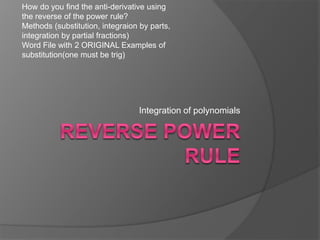Recommended
More Related Content
What's hot
What's hot (17)
Converting fraction into decimals and vice versa(MAth 7)

Converting fraction into decimals and vice versa(MAth 7)
Iteration method-Solution of algebraic and Transcendental Equations.

Iteration method-Solution of algebraic and Transcendental Equations.
Similar to Reverse power rule
Similar to Reverse power rule (20)
Synthetic and Remainder Theorem of Polynomials.ppt

Synthetic and Remainder Theorem of Polynomials.ppt
Create a polynomial function that meets the following conditions- Expl.docx

Create a polynomial function that meets the following conditions- Expl.docx
PRESENTACIÓN DEL INFORME MATEMÁTICA UPTAEB UNIDAD 1

PRESENTACIÓN DEL INFORME MATEMÁTICA UPTAEB UNIDAD 1
More from mlobrien15
More from mlobrien15 (11)
Reverse power rule
- 1. Integration of polynomials How do you find the anti-derivative using the reverse of the power rule? Methods (substitution, integraion by parts, integration by partial fractions) Word File with 2 ORIGINAL Examples of substitution(one must be trig)
- 2. Remember the first way you learned to derive F(x)=2x3 F’(x)=2*3x(3-1) F’(x)=6x2 The power rule derives a polynomial or variable by multiplying the variable’s coefficient by the exponent and subtracting one from the exponent
- 3. To integrate a polynomial you do the reverse Multiply coefficient by exponent Subtract one from the exponent Add one to the exponentDivide the coefficient by the NEW exponent
- 4. So to integrate 6x2 you Add one to the exponent of 2 giving you x cubed And divide the coefficient, six, by the new exponent three giving you: 2x3
